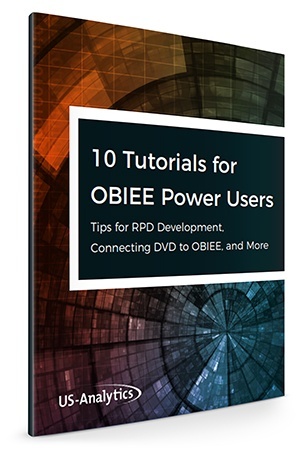Needless to say, you won’t become an OBIEE power user overnight. If you’re new to the tool, you have a lot to learn. If you’ve been using the tool for a few years, you still have a lot to learn. With OBIEE, the learning never stops.
The great news is there are a lot of cool tricks out there that can help you become a better OBIEE user. In this blog post, we’ll cover 5 tips and tricks — and then show you where you can find even more.
Using Presentation Variables
Presentation variables are a powerful feature, but it’s also one of the features that users struggle with most. Presentation variables are like placeholders waiting for a value or a group of values to be passed into them.
Here’s a little about how they work…
- You assign the presentation variable (give it a name) in a prompt to pass the value or group of values selected into the second part.
- The placeholder (presentation variable with the same name) is put in a column formula, column heading, text object, etc.
- The third part is formatting. This is used when you need to apply a format to the values coming into the presentation variable placeholder. There is a massive amount of use cases for presentation variables…
To see an example of how presentation variables can be used, download the free eBook: Using Variables in OBIEE.
Various Functions Used to Make Reports Dynamic for Periods of Time
SYSDATE
The sysdate function returns the current datetime set by the system where the database resides. Sysdate is useful for creating repository variables for use with date dimensions. If you go into SQL Developer, you can write a query to return the current sysdate: select sysdate from dual.
CURRENT_DATE
The current_date function returns the current datetime set by the system where the BI server resides. This datetime may differ from sysdate depending on the geographical location of the database vs. the system that OBIEE resides on. You can write a query using SQL developer to return the datetime using the current_date function.
TRUNCATE
When using sysdate or current_date to create repository variables for dates (which will be shown in an upcoming example), you must keep something in mind. While the date may match, the time may not. To show an example of this, you’re going to join one of your date columns with sysdate.
To learn more about these functions and how they work within a real-life example to create dynamic reports, download the free eBook: Using Variables in OBIEE.
Connect DVD to OBIEE
Oracle’s Data Visualization Desktop (DVD) tool can integrate with OBIEE. Connecting DVD to OBIEE is similar to making a database connection with DVD. However, it’s useful because it allows your user to pull data at the pre-existing report level.
To connect the two, you could refer to the Oracle documentation on DVD... but wouldn’t you rather learn from a seasoned OBIEE consultant? One of our OBIEE experts put together an in-depth tutorial on the topic. For the full tutorial, flip to page 98 in 10 Tutorials for OBIEE Power Users.
Develop a Strategy for Managing Your BI Server Cache
If you’re hearing the moans and groans of users complaining about slowdowns, there’s good news — you can greatly improve the response times of OBIEE dashboards. Using the BI Server cache is something you should consider.
(Disclaimer: If your OBIEE system is poorly designed, this won’t fix it. You can contact our OBIEE experts for help).
So, how should you manage your BI Server cache? You can’t just turn on the BI Server cache, or you might end up with stale data and slowdowns on queries. Learn how to develop a cache management strategy by turning to page 71 of 10 Tutorials for OBIEE Power Users.
Using Concurrent OBIEE RPD Development
If your organization is using OBIEE, you probably have more than one developer... which can create a problem if you’re working in the RPD at the same time. This is why you should enable concurrent development.
Concurrent development allows your team to be more flexible in meeting your business’s delivery demand. But it can be a challenge to manage all this concurrent work.
This is why you need source control. You’re able to track and retain changes, make comments, and even merge changes made to text files. In this eBook, you will find many techniques for source control and even see an example of how it can work. It all starts on page 32.







